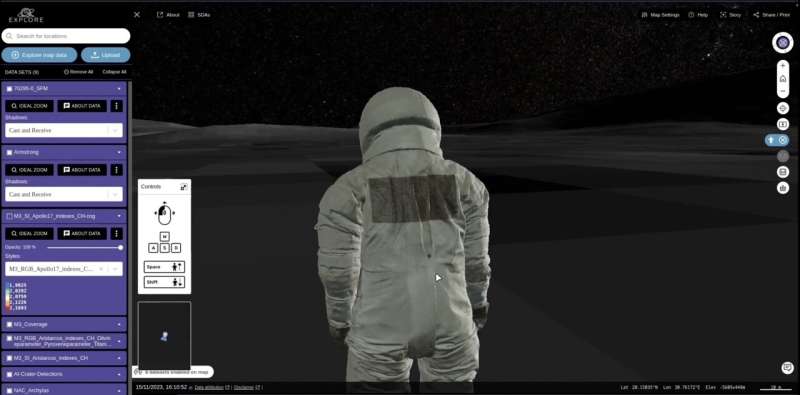This article has been reviewed according to Science X's editorial process and policies. Editors have highlighted the following attributes while ensuring the content's credibility:
fact-checked
proofread
Astronomy toolkit allows users to create their own sky map, find the weirdest stars and explore the surface of the moon

A new set of tools for astronomers and planetary explorers use interactive visual analytics and machine learning to reveal and contrast properties of objects in our galaxy.
From identifying the 'weirdest' outliers in a population of stars to creating maps of the dusty Milky Way or combining datasets for an immersive exploration of the lunar surface, the open-source tools are designed to help astronomers investigate, annotate, and work together on interesting results in a collaborative online environment.
The EXPLORE toolkit, which has been developed by the European Commission's Horizon 2020 program, was presented last month at the Astronomical Data Analysis Software & Systems (ADASS) XXXIII conference and during a technology workshop at the Italian Space Agency's headquarters.
EXPLORE's lunar tools allow users to navigate a 3D model of the moon and upload, display and compare multiple datasets from lunar missions. Zooming in on a location, users can overlay base maps with contours, visualizations at different wavelengths, and spectral information on the mineralogy of the surface. Pre-trained deep learning models help identify craters and map features.
A 'pedestrian view' enables users to visualize themselves standing and moving around the lunar surface through digital elevation models.
Tools for stellar research are designed to investigate the properties of stars in the Milky Way observed by the European Space Agency's Gaia mission and in other large databases. Assigning a 'weirdness score' to spectral data can help astronomers find unusual stars, or groupings that have similar characteristics, within a population of a million stars.
Comparisons of the brightness of stars at different wavelengths can reveal information on the temperature, age, size, and amount of energy stars produce. When applied to a census of all the stars in the Milky Way, these collective results can help unravel the overall composition of our galaxy and how it was built up.
Galactic tools enable users to look at dusty objects and the distribution of dust in the Milky Way in one, two or three dimensions. Slicing through the galaxy in any orientation can reveal where dust is densely clumped and where there are windows that offer potential sightlines to objects of interest. Interactive sky maps show how the dust band at the core of the Milky Way passes overhead through the day and night at any given location on Earth.
Nick Cox, the coordinator of EXPLORE, said, "These EXPLORE science applications are demonstrators for astronomers working in a broad range of fields, including stellar spectroscopy, galactic archaeology, and lunar exploration. Both the EXPLORE tools and the platform they are deployed on are very flexible and can be adapted to other areas of astronomy and planetary science."
Manuela Rauch of the Know Center, who led the development of the visualization tools and user interface, said, "Our goal for EXPLORE is to supply methodologies, tools, and inspiration for others to create their own web apps and services."
Giacomo Nodjoumi of Constructor University, who developed the lunar exploration tools, said, "These new tools for the scientific community are completely open source, modular, expandable, and scalable, with no installation required."
Provided by Europlanet




















